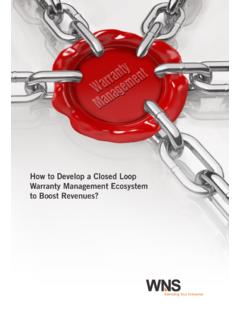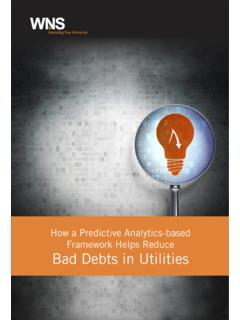Transcription of The Why What and How of a Shared Services Model …
1 WHAT whatHOWWHY whyhowHOWwhatHOWThe WHY, WHAT and HOW of a Shared Services Model for business intelligence & AnalyticswhyHOWWHATWHATHOWB usiness intelligence and analytics (BI&A) applications have the potential of creating enterprise-wide value. However, in a large number of instances, BI&A implementations do not secure the outcomes business leaders and their stakeholders seek from BI&A investments. WHY do business intelligence & analytics implementations fail to deliver expected results? WHAT strategy should you adopt to maximize returns from BI&A investments? HOW do you build a common and centralized hub of business insights the Shared Services BI CoE?This whitepaper answers these three basic, yet complex answer to that is, in most instances, business intelligence & analytics implementations are fragmented and siloed.
2 The conventional fragmented approach can primarily be attributed to the emergence of new low-cost point solutions for data analysis that have encouraged executives of each business unit or department to implement their own business intelligence & Analysis tools and methods. This democratization of BI&A has resulted in the uncontrolled proliferation of tools, local data nnn business intelligence & analytics Implementations do not Always Deliver as Expectedrepositories and analytical management Services . It has contributed to the complexity and confusion as different interest groups within the enterprise try to make sense of data that affects various areas of business you glance a little at history, you will realize that for most organizations, across virtually all industries, the business intelligence function was born as a specialized area to support, enable and sustain narrow areas of investigation.
3 The need to gather and understand data captured by the enterprise was often driven by executives from the office of the Chief Financial Officer (CFO), involved in annual strategic planning activities. Executives would ask their IT departments to query enterprise systems to identify key trends and correlations that would in turn strengthen the strategic planning process. It often took weeks for a response to the analytical request to be fulfilled. This is because the processes for capturing and analyzing data sets from enterprise resource planning (ERP), customer relationship management (CRM), supply chain management (SCM) systems and other assets were manual. The reason: systems were not integrated, and therefore could not talk to each unit analysts often took the reports that the IT organization pulled out of the native systems, and engaged in their own analysis of data sets using spreadsheets that could not be easily Shared , and which were often of inconsistent analytical quality.
4 For many organizations, the trend still an effort to stay on top of markets and trends, different decision-makers across departments within enterprises have begun improvising and developing their own ad-hoc business intelligence and analytics solutions that cannot be leveraged, and which are not validated to provide accurate insight and ensure successful outcomes. Many organizations are wrestling with a crisis of a corporate context because executives do not have access to a comprehensive single version of the truth across structured and unstructured data environments. A fragmented approach to data mining and analysis often leads different executives within the same organizations to end up working with different versions of data. In turn, conflicting conclusions about the nature 01 02of key market dynamics emerge, with contradictory opinions about the best actions to take going forward.
5 The issue of conflicting assumptions based on inaccurate or out-of-context data analysis tends to become aggravated as more business units and geographical areas of operation become involved in BI&A activities. As the market place has become more digital and global, two key imperatives have emerged:There is a need to engage in business intelligence and Analysis more frequently ideally in real-time. A growing group of executives across a range of corporate disciplines (from finance, and marketing, to sales and operations) now need access to accurate business intelligence to support day-to-day decision-making not just annual or quarterly strategic planning processesThe need to coordinate decision-making and strategic planning across the enterprise on a nearly real-time basis requires that executives share a unified vision and version of data.
6 It is also important to adopt a common system of analytical processes that allows different parts of the organization to compare apples-to-apples even though they bring different functional perspectivesAchieving these two crucial business imperatives cannot be driven by the conventional fragmented and siloed approach towards BI&A. The need of the hour is to establish a flexible, accessible, intuitive and centralized Shared Services business intelligence & analytics Center of Excellence (BI & CoE) that can be used to support a variety of enterprise-wide analytical needs. nnStrategy Should Organizations Adopt to Maximize Returns from business intelligence & analytics Investments?A Shared Services BI&A CoE serves as a central hub of business insights for the entire organization.
7 The Shared Services BI CoE is created by breaking the data silos, leveraging / sharing the best practices, standardization and better alignment between technology and business . A Shared Services Model can help an organization to significantly increase its competitive position, better leverage and unlock value of its data assets, enhance organizational capability to generate and action insights to meet its customers changing demands and needs. It also provides senior management with the visibility necessary to monitor decisions and improve effective BI CoE optimizes the interplay of the three most crucial elements in any business people, processes and An effective business intelligence CoE serves as a common resource center that can be used by executives from a variety of backgrounds and expertise to accomplish departmental objectives.
8 Moreover, because it is a Shared Services hub, the analysis and insights developed by one group can be Shared with other departments and disciplines throughout the enterprise to enhance analysis and accelerate the development of new insights. A proficient BI CoE will make it unnecessary for executives to take data out of native BI&A environments. This will in turn reduce the use of individual spreadsheet analysis that can create confusion, inconsistency and unnecessary An effective business intelligence CoE introduces standard operating procedures that greatly enhance the data mining and analysis processes across the enterprise. Additionally, it can play a critical role in identifying opportunities to improve inefficient business operations. BI CoEs can play a vital role in ensuring that both analytical methodologies and business process improvements achieved in one area of the business can be Shared with and adopted by other groups with similar challenges and Technology While there are a growing number of point solutions that provide excellent capabilities for discrete problems in specific situations, the key to success lies in orchestrating each technological element (data capture, harmonization, presentation and analysis) with a thorough understanding of the various internal requirements across the enterprise.
9 An effective business intelligence CoE provides a framework for identifying the right tools for the right applications in the data gathering and analysis processes across the there are a growing number of point solutions and providers that offer excellent capabilities, the key to success lies in applying an optimized mix of business intelligence & analytics expertise with best-in-class technologies and applying them with a thorough understanding of internal enterprise addition to addressing the requirements of various lines of business , a BI CoE in a global company must address the specific needs of operations in specific regions or countries. It is important for senior leadership at the corporate level to provide active input into the various domains, data sets, languages and operational nomenclatures in the business intelligence & analytics step-by-step approach works best for designing a Shared Services Model .
10 This approach analyzes important design elements that are crucial in designing any Shared service you build a Centralized Hub of business Insights the Shared Services business intelligence CoE?By leveraging an optimum mix of people, processes and technology, BI CoEs can help:nEstablish enterprise-wide governance frameworksnGuide BI application development throughout the enterprisenCapture and disseminate best practices as they are discovered and validatednProvide company-wide training and education for BI and analytics processesnCentralize and optimize vendor tools and resources for the entire organizationnStreamline cross-departmental coordination and collaborationnLaying the Strategic Foundation ? The first step in establishing a BI CoE is to begin with the end in mind.







